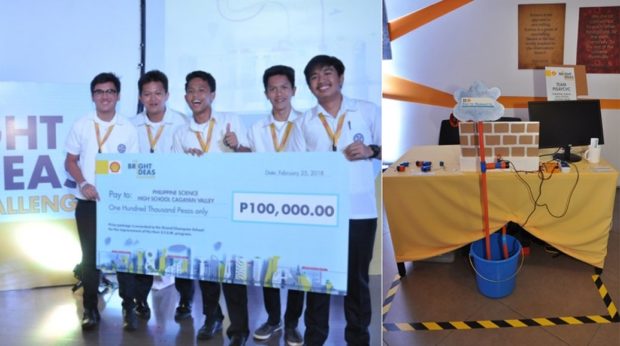
‘ASTIIIIG!’ Young inventors (from left) Daniel Nikko Tumanut, Earvin Michael Bibay, John Paolo Lumanlan, Jose Benjamin dela Cruz and John Lian Mar Catli of Philippine Science High School Cagayan Valley receive their prize as grand winners of Shell’s The Bright Ideas Challenge at Mind Museum in Taguig City. Their winning contraption, “Pipe-to Manalo-to” (right), is a miniature hydroelectric generator that can convert water into electricity using household water pipes. —CONTRIBUTED PHOTOS
CHANGI, Singapore — It took only P100, a bit of curiosity and tons of creativity for several teens from Philippine Science High School (PSHS) in Cagayan Valley to put together a device that generates electricity from water.
The five young inventors bested 26 other teams from other schools in the Philippines and took home the top prize in The Bright Ideas Challenge (TBIC) organized by Shell in February.
Their invention, a pico hydroelectric generator that they dubbed the “Pipe-to Manalo-to” (apparently a play on the title of the sitcom “Pepito Manaloto”), can be installed in water pipes to generate electricity for the home.
Team Pisay CVC leader John Paolo Lumanlan said the group did not expect to win the contest held on Feb. 24 and 25 at Mind Museum in Taguig City.
“We were already packing up when it was announced that we won. I kept shouting, ‘What?! Astig! (Cool)’ as I jumped around,” he recalled.
Lumanlan, 18, and his teammates Earvin Michael Bibay, 18; Daniel Nikko Tumanut, 17; John Lian Mar Catli, 17; and Jose Benjamin dela Cruz, 17, were flown to Singapore to attend Shell’s Make the Future Festival at the Changi Exhibition Center earlier last month.
The all-expenses-paid trip was part of their prize for winning the first TBIC. The prize came with a P100,000 pot for their school’s science, technology, engineering and math (STEM) program, and another P100,000 that the team members said they would use for research and development to further improve their invention.
The team from ERMACC Energy Biñan National High School was first runner-up, while third runner-up honors went to the team from Centro Escolar University Senior High School.
Household application
TBIC recognizes high school students whose inventions illustrate how STEM can tackle real world concerns such as energy sustainability and efficiency.
The Pipe-to Manalo-to, for example, miniaturized the principle of hydroelectric power generation for home application.
The generator uses a Kaplan propeller made from tin cans and fitted into a pipe T-joint.
The T-joint can replace the elbow joints of household water pipes, with the water pressure running the device like a dynamo and the current flowing through an abutting electrical wire.
Lumanlan said the pico hydroelectric generator produced less than 5 kilowatts of electricity, which could charge a cell phone for four hours and power house lights.
The idea to harness the power of water was inspired by the students’ weekly commute from Diadi, Nueva Vizcaya, to the PSHS Cagayan Valley campus in Bayombong.
Bibay, who hails from Diadi, had often noticed how excess water from a nearby watershed would flow out of a pipe at a roadside in his hometown.
“The water was just leaking, and we thought of harnessing the excess energy from that by converting it into electricity,” he said.
The idea was translated into reality with the use of a tin can, a motor from a Tamiya toy car and a T-junction. The prototype cost P100 to build.
Lumanlan said his group would have to improve the turbine made from tin cans given its corrosive nature, as well as the motor’s efficiency and the seals used in the contraption.
No new infrastructure
“If you install our device in your home, you can generate electricity every time you open a faucet,” he said of the conversion of kinetic into mechanical and electric energy.
Bibay, meanwhile, noted that the team’s design did not call for new infrastructure, as it made use of existing pipe systems in the home.
“It can be done even at home on a small scale,” he said.
Their device can also be used in future cities and high-rise buildings as long as water pipe systems continue to exist, Lumanlan said.
“As long as the concept of pipelines exist, our technology can be used,” he added.
Jenshiam Balgua, who teaches technology at PSHS Cagayan Valley, acted as the team’s mentor and had nothing but praise for his young wards, who thoroughly enjoyed themselves at the exhibition center in this city.
“These kids are the ones who did it all, and did it well,” Balgua said. “For me, winning was just a bonus. These are the moments when I feel happy to have played a role in the lives and future of my students,” the 37-year-old mentor said.
Most of the young inventors said they wanted to study at the University of the Philippines Diliman, where they hoped to invent more useful contraptions in the future.
The boys also expressed optimism that other young inventors would be given the chance to shine.
“They should not stop realizing their ideas. An idea is already something they can act on,” Lumanlan said.
For Tumanut, it was important for young minds to “wonder and wander.” He added: “If you stop being curious, then you stop being a scientist.”
For Dela Cruz, winning the TBIC was just a stepping stone for himself and his teammates. “We’re just students and we have the rest of our lives ahead of us. We won’t stop here. If you want to have more, sometimes you need to go beyond your comfort zone,” he said.